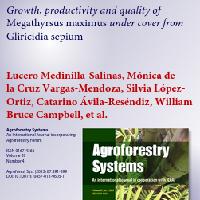Resumen
- The effect of tree canopy on the growth, productivity and forage quality of Megathyrsus maximus and changes in soil properties were evaluated over three seasonal periods. Four adjacent plots (15 m × 17 m each) in a tropical secondary deciduous forest having 12 years of growth and dominated by Gliricidia sepium were randomly assigned to two treatments: removal of trees (SCA) in two of the plots and leaving trees intact (COA) in the other two. In all plots, M. maximus was planted with 50 cm spacing among plants. Tree removal significantly increased the incident photosynthetically active radiation (PAR, P < 0.001) and grass size (12.5 % in height, P < 0.01, and 16.5 % in clump diameter, P < 0.05), but did not significantly affect any other variable. Season significantly affected grass height (P < 0.003), tiller number (P < 0.001), clump diameter (P < 0.001), net CO2 assimilation rate (P < 0.001), forage biomass production (P < 0.003), and acid detergent fiber content (P = 0.033). Primary soil changes after 1 year of establishment of the grass were the decline by 3 % in organic carbon (P = 0.03), and qualitative changes in soil structure, regardless of tree presence. Results are consistent with the ability of M. maximus to tolerate shade. We conclude that under the conditions of the study there was no evidence for a negative effect of tree canopy on M. maximus mediated by a reduction in PAR.
